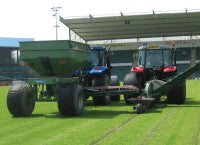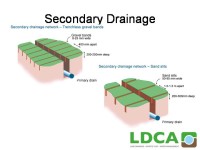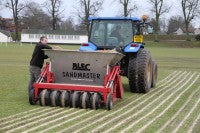Trench campaign
 Whatever the sporting activity, efficient drainage is essential to maintain a good playing surface. Loss of use, due to waterlogging or turf damage, can result in a backlog of games, dissatisfied sportsmen, lost fixtures and even serious financial losses.
Whatever the sporting activity, efficient drainage is essential to maintain a good playing surface. Loss of use, due to waterlogging or turf damage, can result in a backlog of games, dissatisfied sportsmen, lost fixtures and even serious financial losses.
An efficient drainage scheme will eliminate waterlogging, reduce compaction and allow easier maintenance and more flexible management of valuable resources. Improved drainage will result in improved soil structure and a better quality grass sward.
Design
Professional design and expert installation are regarded as equally important factors in any successful drainage scheme.
The design of individual drainage schemes depends on the underlying soils, the site location, the sporting activity, the amount of usage and finance available.
Site investigations, including topographical and soil surveys, should be undertaken before design to permit accurate assessment of drainage needs and problems.
The provision of a suitable outlet for drainage water should be considered - this may be an existing land drain or watercourse or, alternatively, an engineered soakaway or pump chamber may be an option. When discharging drainage water, permission from the relevant authority may need to be sought.
The minimum depth of cover on any piped drain should be at least 450mm, to protect the pipe from damage due to surface traffic or maintenance operations such as deep spiking.

The use of permeable backfill is essential in all sportsturf drainage, as this provides a free draining connection to the drains. This should extend sufficiently near to the surface to ensure adequate water entry into the drains and intercept any secondary drainage.
Inspection chambers and silt traps should be incorporated into the scheme to allow for inspection and maintenance.
Drainage plans should clearly show the location of the drain runs, spacings, levels and other relevant information necessary for the correct installation.
Consideration should be given as to whether the soil arisings from the works are to remain on site or be removed.
Materials
Plastic land drainage pipe should conform to BS4962. Purpose-made junctions and connectors should always be used when joining pipes.
The choice of permeable backfill is imperative to the long term success of the drainage scheme as, by definition, it allows the passage of water from the surface to the pipe. All backfill material placed over drains should be durable, evenly graded and free from pollutants.
All drainage outfalls into watercourses should incorporate suitable headwalls fitted with a vermin guard.
Workmanship
The professional installation of sportsturf drainage systems involves the use of specialist plant and machinery, and it is important that all those involved are fully equipped and experienced.
Best practice is to install sportsturf drainage when soil conditions are suitable. Impairment to the efficiency of the drainage, soil compaction, rutting and other soil or turf damage may take place if work is carried out when there is a high water table, puddles or saturated soil conditions.  All wheeled equipment should use low ground pressure tyres.
All wheeled equipment should use low ground pressure tyres.
When draining through existing turf, every care should be taken to prevent contamination of the surface with soil or backfill materials.
Excavation of the drainage trench should be carried out using a continuous chain trencher fitted with laser controlled grading equipment and a spoil removal conveyor to prevent contaminating the surface with subsoil.
Drainage pipe should be laid on a pre-formed trench bed, and backfilled as specified using machinery specifically designed to place backfill into the trench without spillage of the backfill onto the surface.
Secondary drainage treatments
 Secondary drainage, such as sand slitting or banding, may be added to a primary piped drainage system to increase surface infiltration and improve drainage of the surface and upper part of the growing medium.
Secondary drainage, such as sand slitting or banding, may be added to a primary piped drainage system to increase surface infiltration and improve drainage of the surface and upper part of the growing medium.
"Sand slitting" refers to narrow trenches from which the soil has been removed, usually 50mm wide and 200-300mm deep, partly backfilled with gravel and topped with sand.
Gravel or sand banding refers to where soil has been displaced by a knife or tine and a band of gravel or sand is placed simultaneously.
Maintaining the drainage
 Settlement of drain lines may occur as a result of drier soil conditions and/or periods of dry weather. As this would affect the playing surface, it is important that topping up is carried out as this becomes apparent.
Settlement of drain lines may occur as a result of drier soil conditions and/or periods of dry weather. As this would affect the playing surface, it is important that topping up is carried out as this becomes apparent.
Following drainage operations, regular sand top dressing of the surface is recommended.
Surface compaction and smearing, due to intensive use in wet weather, significantly reduces infiltration and can cause waterlogging. Various types of machines are available to introduce tines into the surface to relieve compaction in the surface and topsoil layers and restore drainage infiltration.
Information on drainage and a list of contractors is available from the Land Drainage Contractors Association website www.ldca.org and click on Members Directory.
Tel: 01327 263264
Email: secretary@ldca.org
